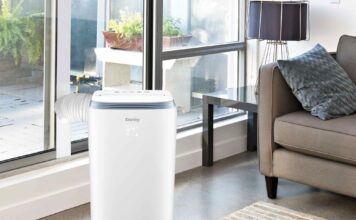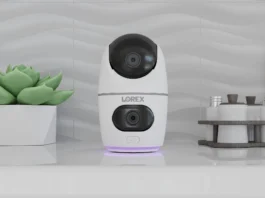 Airthings monitors provide insight into the air quality of your home. You can only learn some things with special technology. Airthings provides the tech that sees what you can’t. For example, Radon levels in your home have no odour and the bad effects on your body from Radon exposure take a long time to develop. Only with these insights can you take action before things like Radon can hurt you. In this contest Best Buy and Airthings will equip two winners with great Airthings monitors.
Airthings monitors provide insight into the air quality of your home. You can only learn some things with special technology. Airthings provides the tech that sees what you can’t. For example, Radon levels in your home have no odour and the bad effects on your body from Radon exposure take a long time to develop. Only with these insights can you take action before things like Radon can hurt you. In this contest Best Buy and Airthings will equip two winners with great Airthings monitors.
Is the air in your home as clean as you need to be
This is a question that most of us can’t answer without a monitor to detect the presence of harmful gases or particulates in the air. Airthings monitors are designed to inform homeowners about a range of conditions in your home. For example, they can tell you the concentration of Radon gas in your home.
Most people are unaware that Radon gas is the second leading cause of lung cancer. Fewer people smoke these days, which is reducing the number of new lung cancer cases in Canada. However, Radon exposure is not something you can “just say no” to; you first need to know when it’s there. Radon is a natural byproduct of the constant process of radioactive decay that occurs all over the world in the Earth’s crust. Under your home, radon gas is produced and seeps up. It can then become trapped in your home, increasing to unsafe levels unless you act accordingly.
What can you do about Radon
Is the radon levels in your home safe? Unsure? The first thing to do is to get a device that can detect Radon. The blog team has reviewed several Airthings monitors over the past few years and we found that they are easy to set up and the information they provide about the air quality in your home is easy to understand. We also sent an Airthings Radon detector across the country to get readings in many cities where writers on the team live. The results varied dramatically; the highest levels (from our tests) were observed in southern Ontario.
 But no matter where you live in Canada, your home may have higher Radon levels than you would prefer. Testing the radon levels is the first step. Health Canada recommends you do this during colder months when windows are more likely closed—so now is a great time to get a monitor. If radon levels are high, you may need to hire a contractor who can identify areas of your home that can be sealed (e.g., cracked foundation, ground level pipes, etc).
But no matter where you live in Canada, your home may have higher Radon levels than you would prefer. Testing the radon levels is the first step. Health Canada recommends you do this during colder months when windows are more likely closed—so now is a great time to get a monitor. If radon levels are high, you may need to hire a contractor who can identify areas of your home that can be sealed (e.g., cracked foundation, ground level pipes, etc).
Which Airthings monitor is best for your home? We recently sent two different models to Shelly and Myriam for reviews in English and French. Each of the two winners of this contest will get both of those monitors. You could put one in the hallway near the bedrooms and one in the living room (areas of the home where your family spends most of their time). Think about that, then enter the contest.
How to enter
Entering this contest is easy and you can enter in two different ways.
- In a comment below, tell us in what area of Canada you live (general area or city is fine) and if you know what the radon levels are like in your area of Canada and if you ever had your home tested.
- In a comment beneath the review article on the blog, tell us where in your home you would put each of the two prizes if you win.
What you can win
At the end of this contest, we will randomly select two winners. Each winner will get an Airthings View Plus Air Quality Monitor and an Airthings View Smart Radon Monitor.
This contest runs from Oct 31st to Nov 13th.
Remember you can enter in two different way. Your friends and relatives will also want to know if the air quality is safe in their homes, so share this contest with them too.







































In the Montreal area, no idea what’s the radon levels around, and I haven’t tested yet.
live in ontario and don,t know the levels
I live in Winnipeg, Manitoba. I am unsure of the radon levels in my area. I have not had my home tested.
I live in Southern Ontario and I am unsure what the Radon levels are in my area and I have not had my air tested
Vancouver.. I’m not sure what the radon levels are in my home
I live in Kingston, Ontario. I don’t know the radon levels and I’ve never had my home tested.
Vancouver, never tested and don’t know the levels :s
I live in a small town name Val-d’Or, in the province of Québec. We do not know the radon levels in the area and we have never tested them. I would love to know since to much radon can be harmfull for me and my family. I would put one in the living room upstare, and one in the living room downstair! Thank you for this opportunity!
I live in Saskatoon, I do not know the radon levels of my home, nor have I have ever tested. Thank you.
I live in Toronto. I do not know the radon levels of my home, nor have I have ever tested.
Reside in Ontario – do not know the radon levels & have not tested
Victoria BC and I have no idea of the levels, and have not tested
I live in Montrea. I do not know the radon levels and have not tested.
I live in Winnipeg, and am unsure of the radon levels in my area. We’ve not had our home tested.
I live in Eastern Ontario. I’m not sure what the radon levels are for this area and I have not had my home tested.
I live in Eastern Ontario, I don’t know what the radon levels are in my area, and I have never had my home tested
Live in Ontario, don’t know what levels
I live in Saskatoon and had a radon test last year. Thankfully, the levels were very low, unlike some parts of Saskatchewan.
Live in Ontario, don’t know what levels are.
Saskatoon, no I dont, but we plan to test
GTA, never tested, don’t know the levels
Live in Ontario, don’t know what levels are. Never thought to test.
I live in Ontario and have never tested my radon levels. But I definitely should. Don’t know what radon levels are here.
I live in Thunder Bay and love the smell of radon in the morning.
There would be one in the bedroom and one in the basement laundry room
Residence –Saskatoon .The levels are high but have never had my home tested.
I live in NB, Canada. I don’t know the radon levels in my area of Canada (but I will do some research) and my home has never been tested (yet)!
I live in the gta and have no idea the radon levels!
Brockville ONT, we do not know our radon levels, nor have they been tested before.
I live in the GTA, but don’t know much about the levels here. I’ve never had mine tested.
I live in Vancouver. I do not know the radon levels in my area and I have not had my home tested.
Montreal – no idea what radon levels or air quality are in my house but would love to know
I live in Hamilton but have no idea our lvls here. I have family in Blenheim that could use this for sure.
I live in Winnipeg. I do not know the radon levels in my area and I have not had my home tested.
Waterloo Region and no, I have no idea what the air quality is like here, which is why these devices would be great.
Northern BC, radon levels vary a lot depending on soil conditions, so every location is different. I have not had my radon levels checked.
I live by Regina, Sask. I have never had my home tested for radon
I would put one in the hallway leading to the bedrooms and one in the basement in the laundry room
Edmonton, Alberta-I have no idea and no we have never gotten tested.
Downtown Calgary – no idea; who knew?
Calgary – never heard of this
Medicine Hat – no testing done
Medicine Hat – no idea
I would put one in the bedroom and one in the basement laundry room
I live in Saskatoon and the levels are high but have never had my home tested.
Southern Ontario, have tested
I live in Stoney Creek, ON. I was told that Radon levels in the Niagara area are high. I had my radon levels checked a long time ago in the basement. Would love to do it again.
We live in Toronto and have never had our home tested. I have no clue what the radon levels might be!
I live in southwest Ontario where radon levels are generally high. Our radon level was tested a year ago with a single use test and came in at 90 ppm in our basement (Health Canada recommends levels not exceed 200 ppm). Levels are typically higher in lower levels, areas of poor ventilation and in winter, so basements are generally highest levels.
1. In Vancouver
2. I don’t know the radon levels
3. Have not tested
I live in Mississauga and I do not know the radon levels nor have I ever been tested
Comments are closed.